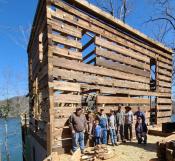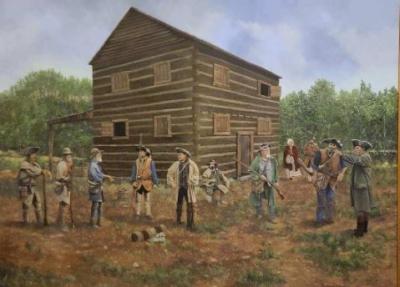Commemorating Russell's Fort - Featured on the 9/26/23 Daily Courier
Art Includes Local Faces
BY SCOTT CARPENTER SCARPENTER@THEDIGITALCOURIER.COM
LAKE LURE — James Sciandra continues his quest to preserve some of Rutherford County’s rich history. He recently unveiled a painting he had commissioned by a noted artist, which depicts how the original “Russell’s Fort” would have looked in the 1700s, sitting along what is now Chimney Rock Road (U.S. 64/74) just outside Lake Lure. That structure, which served as a fort, eventually had additions made to it as it transformed many years later to what many knew as Pumpkin Center. There was once even a sign proclaiming the property “Pumpkin Center of the South.” The recently completed painting by Richard Luce hangs in the reborn Russell’s Fort, now overlooking Lake Lure.
Much has changed since James, whose primary residence is in Florida, discovered Rutherford County. He had been hoping to acquire a vacation home, and remembers his beloved grandfather, Charlie Sciandra often said, “We should get a cabin in the mountains.”
James eventually acquired property on Lake Lure, which included a cabin built in 1938. He restored that building.
Then, in 2020, through a handshake agreement, Brad and Jamie Peters gave the Pumpkin Center/Russell’s Fort structure to James, on the condition that he move and restore the building in Lake Lure.
In the spring and summer of 2021, James and a team of construction workers carefully took down the entire Pumpkin Center addition, leaving the original Russell’s Fort exposed.
Almost two years ago, in October 2021, the team from the Barnwood Builders television show came to Rutherford County. Barnwood Builders numbered each piece of wood as they carefully disassembled Russell’s Fort. Each piece was tagged, loaded onto moving trucks, and transported to West Virginia, where the wood was treated and prepared to be “re-used.”

In November 2021, James worked with another team to build the foundation for the new location of the Fort, on his lakefront property called White Oak Point, on Gentle Winds Lane.
And in March 2022, the Barnwood Builders team came to Lake Lure, where Russell’s Fort was reassembled. Crews filmed the entire process, which was featured on the Barnwood Builders television show.
Finally, in April 2023, construction was officially completed, and James received the Certificate of Occupancy on the Russell’s Fort structure.

Since that time, throughout the summer, James along with family and friends, have spent much time here, enjoying the beauty of Lake Lure. The Russell’s Fort structure has a new foundation, and new back and front additions. These additions were made using much of the material from the original Pumpkin Center.
“This building really pays homage to history. Both, to the history of the original Russell’s Fort, and also to Pumpkin Center,” James said recently. “We wanted to honor both. Many in Rutherford County loved, and have fond memories of traveling to Pumpkin Center.”
After spending a lot of time, energy, and resources, bringing Russell’s Fort back to life, James was asked if the final outcome was worth the effort.
“Absolutely, 100%,” James said. “This has been an honor and a privilege for me. Through this entire process, through spending so much time here, I have grown to truly love the people of Rutherford County.”
James said lately, he is in Rutherford County more and more.
“I intend to eventually retire to Lake Lure,” he continued.
The reborn Russell’s Fort now includes four bedrooms, four and a half bathrooms, living, kitchen and dining areas. It has several decks with glorious views of Lake Lure. The structure is a rectangle, two and a half stories tall.
James had the vision, he spearheaded, and was the driving force behind the Russell’s Fort/Pumpkin Center project. But he quickly gives credit to the individual construction workers, craftsmen, and others who supported the project throughout the process.
James had the idea to honor some of these people, when he decided to commission a painting of Russell’s Fort. Historical artist Richard Luce, who lives in Kentucky, took on this project.
“I had this idea, that I wanted an original
painting of how the fort might have looked back in the 1700s,” James said.
Included in the painting are 11 people outside the building. They are dressed as if it were the 1700s. And they have the faces of 10 local people, who were instrumental in the entire project, along with the face of the artist.
According to James, Luce had these individuals gather at the fort for a photo shoot. The artist had brought period costumes for them to wear. He later painted them, using the photo as a guide.
These 11 people in the painting are, (left-right): Richard Luce, Steve Ricker, Dalton Wade, Wayne Harper, Humbert Buchanon, Rock Harper, Harold Harper, Clete Cogdell, David DiOrio, Jamie Peters and Brad Peters.
James is pleased with the painting, and it was officially revealed recently at a party at Russell’s Fort, hosted by James to honor the project supporters.
“I love the painting,” James said. “It’s perfect. And it memorializes some of the important people who were a part of this.”
Next spring, James plans to make Russell’s Fort as well as the smaller cabin on the property, available to the public on a short-term rental basis.
Landmark is Steeped in History
BY David R. DoOrio SPECIAL TO THE DAILY COURIER NOTE: This article originally appeared in The Daily Courier in March 2022.
LAKE LURE — A local historical landmark has found a new home in Lake Lure. Russell Fort, previously located east of town along U.S. Highway 64/74 on the Rocky Broad River, was disassembled and restored by the team from the hit TV series “Barnwood Builders” and is being reassembled near the shore of the lake on Gentle Winds Lane.
James Sciandra of Lake Lure, with the help of local craftsman Harold Harper, reached out to Barnwood Builders to preserve this important symbol of local history. He plans to resurrect the Fort using the original timbers to preserve the history for future generations. Two shows will feature the move and will be shown on the Magnolia Channel later this year.
The history of the Fort is a great American story about a patriotic and pioneering family that settled on the western most frontier of North Carolina along an established border with the Cherokee Nation. Just before the American Revolution an Irish immigrant, George Russell Sr., married a local widow, Mary Whiteside, and settled along the banks of the Rocky Broad just South of Hickory Nut Gorge where Lake Lure Marine stands today. In 1767, the Royal Governor of North Carolina, William Tryon, negotiated a treaty with the Cherokee to reduce tensions by promising to cease westward settlement across an agreed borderline that extended from South Carolina to Virginia.
George Russell Sr., a founding member of the Tryon County (later Rutherford County) Committee of Safety, arranged for the construction of the Rocky Broad Station, a militia supply and mustering point to protect local settlers near the border line. The Station served as a home, center for trade, and a rallying point for protection. In 1775, additional buildings were constructed on the high ground (Russell’s Fort) to guard against an emerging Loyalist and persistent Cherokee threat; allies to the British.
During the American Revolution (1780), British Maj. Patrick Ferguson, a promising young officer and trusted aide to Lord Cornwallis (the Commanding General of British Forces in the South) was ordered to scout Western North Carolina to recruit and train a Loyalist cavalry unit and subdue the Patriot militias. The British tactics were ruthless. The British threatened families, coerced young men to join at the “tip of a bayonet”, foraged scarce food reserves, and confiscated family valuables. In September 1780, Ferguson established a short-term base camp at Gilbert Town, just north of Rutherfordton. According to family historical archives and confirmed in soldier diaries; the area, including Russell Station was raided by Ferguson’s men.
After a skirmish on September 12, 1780 on nearby Cane Creek, the British encamped for 10 days within a few miles of the station. The Russell family received advanced warning and fled, but had enough time to hide the family silver and coveted linens in a “hogshead” or small barrel. Ferguson’s men plundered the station and confiscated valuables including the silver. The raid is documented as the westernmost British raid during the war.
Within days of the raid, Ferguson’s loyalist cavalry rode to Charlotte to join with the main British Army. On October 7, 1780, his legion was cornered at Kings Mountain by Patriot militia units from across the region (called Overmountain Men) and was decimated. Maj. Ferguson was killed and several Loyalist prisoners were marched back to Gilbert Town, tried, and hung for treason.
The raid marked the start of a series of engagements that significantly weakened the British Army through attrition and restricted their movement in the back country. Lord General Cornwallis was forced to vacate the Carolinas in 1781 and deployed into Virginia where he was decisively defeated at the Battle of Yorktown in October 1781. The raid at Russell Fort epitomized the British failure to win the “hearts and minds” of Carolina settlers that ultimately led to their defeat and the birth of our nation.
George Russell returned to Russell Station after the raid. He was an avid bear hunter and unfortunately ventured West into Cherokee hunting grounds where he was killed in 1782. His stepson, John Whiteside Jr., assumed duties as the family patriarch. As a venerated Patriot leader in the Battle of Kings Mountain, the new government offered him possession of property that was “marked within one day’s ride.” John took advantage of that offer, and much of Hickory Nut Gorge as far as Rumbling Bald was settled and farmed by the Whiteside family descendants later to be known as Whiteside Valley.
For the next 200 years, the original hand-hewn log structure was occupied by the Whitesides. Around 1893, during the post-Civil War “Reconstruction Period”, the Rev. Zachary Taylor Whiteside built a plantation farmhouse around the original logs to elevate the property to a higher level of prominence.
The farmhouse exterior protected much of the log framework, enabling the restoration effort today. The farm was affectionately known as the “Pumpkin Center of the South” during the 1950s, 60s, and 70s, where thousands of pumpkins were prominently displayed and children played in the extensive pumpkin fields.
The patriotic Whitesides, many who followed tradition and served in the military, stood proud as they watched the filming of their ancestral home being preserved. Russell Fort continues to stand tall as a symbol of protection for our nation at the time of its inception to a new mission of standing watch on Lake Lure, a timeless icon of American freedom and North Carolina heritage.


